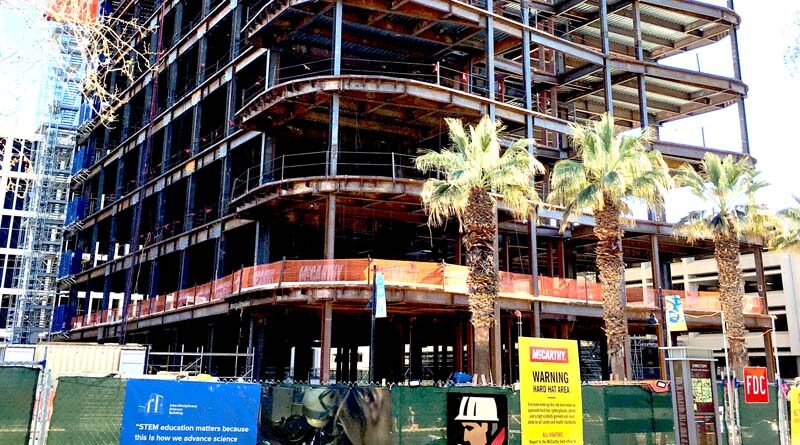How Education Projects Can Move Forward Safely During the Pandemic
By Andrew Murray
As construction projects across the spectrum continue to grapple with waves of uncertainty due to the COVID-19 pandemic, education facilities in California have been regarded as “essential” since early in the crisis and allowed to continue. While work can proceed, the challenge of determining how to move forward during these unique conditions is an important issue. The missions of maintaining worker safety while successfully advancing projects in an ever-shifting regulatory environment requires creative thinking and straying from traditional operational procedures.
Among the essential project roundup is San Jose State University’s new Interdisciplinary Science Building (ISB), the first new academic building on campus in more than 30 years and the first new science facility in almost 50 years. The eight-story design-build structure will serve the 3,000 undergraduate and graduate students within the College of Sciences and STEM majors from across the university. The ISB is the first phase of the San Jose State University’s new Science Park and part of a large effort to revitalize downtown San Jose. McCarthy’s Andrew Murray, project director of the ISB, shares strategies and construction pivots implemented on the jobsite while navigating the unique circumstances stemming from COVID-19.
Communication is key
Working through an unprecedented time requires clear and open communication from everyone involved on the venture. Utilizing a design-build delivery method allowed the entire ISB team – owner, builder, designer and other stakeholders – to integrate early and create a culture of trust and transparency. From the outset and before the pandemic hit, mutual agreement among all parties helped establish conditions of satisfaction, clarified decision-making processes, and set the tone for high performance and success. The all-in design-build consensus has played an instrumental role in evaluating how to best move the project forward.
Determining next steps for the ISB during the region’s initial shelter-in-place mandate involved working closely with the client and the county to determine if construction could continue and what was considered “essential.” Once the ISB was determined eligible to move forward, the team adapted new norms for adhering to safety regulations and remaining connected, such as holding meetings and orientations virtually or socially distanced outdoors. Rather than standing together to watch a video, information and communications are distributed in small outdoor groups and on posted on message boards.
Safety over everything
On any job – pandemic or not – safety needs to be the top priority. McCarthy is always laser-focused on safety, but the pandemic has heightened awareness on a larger scale and approaches to work have changed. Once the ISB was deemed “essential” and work could continue, the team developed a COVID 19 site-specific Safety Plan to manage aspects of pandemic safety on the jobsite.
Guidelines included:
- Staggering shifts to have multiple, socially distanced people on-site at one time
- Conducting health screenings on every one that comes on-site
- Providing proper personal protection equipment
- Regularly cleaning tools and implementing no-sharing policies
- Increasing cleaning of frequently touched areas, such as wash stations and porta-potties
- Elevating task-hazard analysis processes
- Changing manlift access – going from 30 riders to three of four
On a broader, company-wide level, McCarthy is one of the founding partners that helped launch the “NEXT Coalition,” a national alliance of leading construction and design companies aimed at promoting and sharing industry safety best practices. The collective effort leverages the deep expertise of all partners and seeks solutions in areas that include safety policy compliance, screening, tracking and tracing, real-time communication, incident tracking, data analytics and others. An experienced safety team is critical for ensuring health and wellness and implementing proper precautions and plans to avoid a jobsite outbreak.
Adapt
To maintain the project’s schedule, the team continually evaluates ways to take advantage of opportunities to continue the ISB’s progress. While the overall timetable of the build hasn’t accelerated, the design-build team has implemented strategies to avoid falling behind due to delays resulting from the COVID-19 landscape.
The most significant pandemic impact on the site has been the absence of students and regular activity. Lack of foot and vehicle traffic has sped up deliveries, mainly because the site has a single road for access from public streets. Typically, the road is filled, so removing traffic reduces risk and logistical complications considerably. The alleviation of road congestion and risk allows for work to progress quicker and easier.
Flexibility, experience and focus are vital for responding to adversity quickly and safely, and complex projects of this scope and scale require a keen eye and technical expertise to mitigate risk and address unexpected challenges to deliver a quality final product. Facilities like the ISB, where learning and research will be combined to transform the way science principles are taught, will serve as important resources for looking at ways to address future potential outbreaks.
Andrew Murray is a project director with McCarthy Building Companies. With more than a decade of experience on a variety of complex projects, his project expertise encompasses a range of project types throughout the San Francisco Bay Area, including the New Stanford Hospital, UC Berkeley’s Li Ka Shing Bio-medical Center and facilities for various high-profile biopharma companies. He can be reached at AMurray@McCarthy.com.

